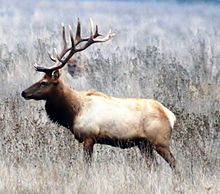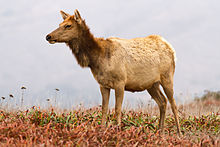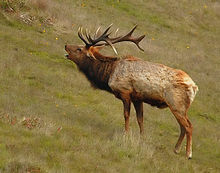| Tule elk | |
|---|---|

| |
| Tule elk bull at San Luis National Wildlife Refuge | |

| |
| Tule elk cow at Tomales Point, Point Reyes National Seashore | |
| Scientific classification | |
| Domain: | Eukaryota |
| Kingdom: | Animalia |
| Phylum: | Chordata |
| Class: | Mammalia |
| Order: | Artiodactyla |
| Family: | Cervidae |
| Genus: | Cervus |
| Species: | |
| Subspecies: | C. c. nannodes
|
| Trinomial name | |
| Cervus canadensis nannodes (Merriam, 1905)
| |
| Synonyms | |
|
Cervus elaphus nannodes | |



The tule elk (Cervus canadensis nannodes) is a subspecies of elk found only in California, ranging from the grasslands and marshlands of the Central Valley to the grassy hills on the coast.[2] The subspecies name derives from the tule (/ˈtuːliː/), a species of sedge native to freshwater marshes on which the tule elk feeds. When the Europeans first arrived, an estimated 500,000 tule elk roamed these regions, but by 1870 they were thought to be extirpated.[2] In 1874–1875 a single breeding pair was discovered in the tule marshes of Buena Vista Lake in the southern San Joaquin Valley.[3] Conservation measures were taken to protect the species in the 1970s.[4] Today, the wild population exceeds 4,000.[5] Tule elk can reliably be found in Carrizo Plain National Monument, Point Reyes National Seashore, portions of the Owens Valley from Lone Pine to Bishop, on Coyote Ridge in Santa Clara Valley, San Jose, California and in Pacheco State Park and areas surrounding San Luis Reservoir near Los Banos, California.
- ^ NatureServe. 1988. Cervus elaphus nannodes, Tule Elk. NatureServe, Arlington, Virginia. Available https://explorer.natureserve.org/Taxon/ELEMENT_GLOBAL.2.103199/Cervus_elaphus_nannodes. Accessed 9 December 2021.
- ^ a b Cite error: The named reference
Linwas invoked but never defined (see the help page). - ^ D.R. McCullough; J. K. Fischer; J. D. Ballou (1996). D.R. McCullough (ed.). From bottleneck to metapopulation: recovery of the tule elk in California, in Metapopulations and wildlife conservation. Covelo, California: Island Press. pp. 375–403. ISBN 978-1-55963-458-8.
- ^ Brick, Michael (January 6, 2009). "Bow Hunters' Quest: Stalking an Elk and a Record". New York Times. Retrieved May 26, 2010.
- ^ Cite error: The named reference
Kanwas invoked but never defined (see the help page).
